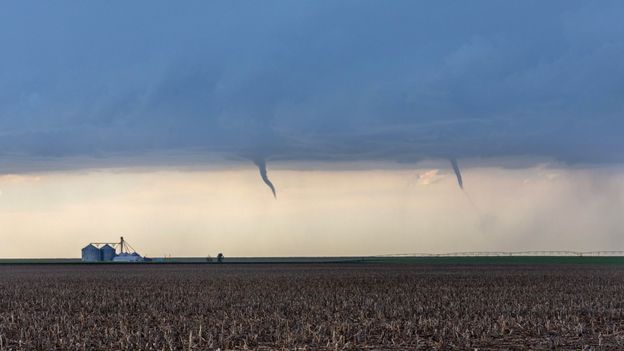Can we get the article text in here?
It’s that time of year when tornado alley swings into action. But is it moving?
Somewhere between the ancient peaks of the Appalachian Mountains and the frosted caps of the Canadian Rockies is “tornado alley” – a meteorological corridor that’s uniquely susceptible to these violent weather events.
Each spring and summer, as warm air from the equator meets cool air from the north, citizens across the Great Plains of the central United States find themselves running the gauntlet of tornado season – swirling columns of 300mph (483kph) winds that appear with little warning, flattening entire settlements, tossing cars into the air and turning the debris of their destruction into lethal missiles.
Now a city in the heart of this danger zone has taken a direct hit – on Thursday night a tornado ripped through Perryton, Texas, injuring 75 people and killing three. The latest research suggests that similar incidents are set to become more common across the US. Though the central states currently witness more tornadoes than anywhere else, in future, the main area of peril could also include the southeast. In fact, tornado alley is widening.
Origins of an alley
Tornado alley is not a scientific term – it was invented by two meteorologists from the US Air Force in the 1950s to refer to severe weather around Texas and Oklahoma. The region’s exact horizons are highly variable, with some maps suggesting it stretches as far north as the Dakotas and as far south as Illinois and Indiana. However, it is usually broadly synonymous with the Great Plains, and typically includes states such as Texas, Oklahoma, Nebraska and Kansas. It’s no accident that the classic children’s story The Wizard of Oz, in which (spoiler alert) a tornado uproots Dorothy’s isolated farmhouse – and moves it with uncharacteristic care – is set in the latter.
The United States experiences some 1,200 tornadoes every year, leading to hundreds or even thousands of millions of dollars of damage and an average of 71 deaths. Most of these occur in tornado alley – though not all of them. Back in late March and early April, a swathe of tornadoes ripped across the Midwest and Southeast US, forcing people to take cover behind mattresses, inside closets, and even within bathtubs – one couple was sheltering in theirs when it was lifted off the ground.
Changing times
Last year, scientists from the City University of New York announced an unexpected development. Tornado alley, with its dubious geographical perimeter, has been migrating. Between the 1950s and the 1980s, the corridor’s classically accepted boundaries were broadly respected by these weather events. But in the last three decades the country has been experiencing a radical shift, the researchers found, with a higher frequency hundreds of miles away, in the southeast and “Dixie Alley” – a region of the southern US with a history of particularly violent tornadoes.
Today it’s thought that tornadoes may be occurring less often in the Great Plains, according to another paper. At the same time, large tornado outbreaks have become most common in Alabama, Tennessee, and Kentucky.
WHY IT MATTERS On Friday morning, the residents of Perryton tentatively emerged from their shelters into a scene of utter devastation – the splintered wreckage of homes, and streets of rubble strewn with downed power lines. But compared to elsewhere in the US, the inhabitants of tornado alley are prepared for such disasters. As these weather events become more common elsewhere, there is concern that fatality rates could increase.
It’s not clear why this transition to the southeast has occurred. The City University of New York researchers suggested that it might be down to a combination of localised conditions, such as warm temperatures, and the impact of hurricanes, which have been tentatively linked to tornadoes in the past. Could climate change also be partly responsible?
Most tornadoes have their origins in “supercells” – vast, grey discs of cloud that loom over the landscape like alien spaceships. Most of the time they manifest as ordinary storms, fed by warm, humid currents from below. But occasionally these columns of air start to rotate, forming an invisible tube of air within that spins horizontally. No one knows why, but these can then become “tipped”, turning them into the vertical vortices of destruction that we know as tornadoes.
Because tornadoes thrive on warmth, it’s thought that climate change could be increasing their frequency in some areas – perhaps even in the southeastern US, though this has not been studied yet. However, the link between these extreme weather events and climate change is highly complex, and the science is far from certain. And the evidence that tornadoes have become more common overall is also still limited.
So, it seems tornado alley is on the move – but why this is happening, and where it may end up, both remain to be seen.
–
Thanks. I am from the south, and tornados scare me. No one in my area has any kind of shelter for them either
Thank you for transcribing!




